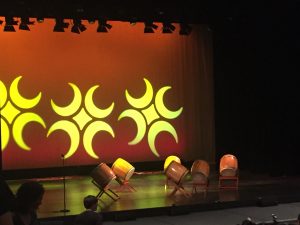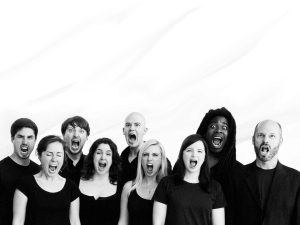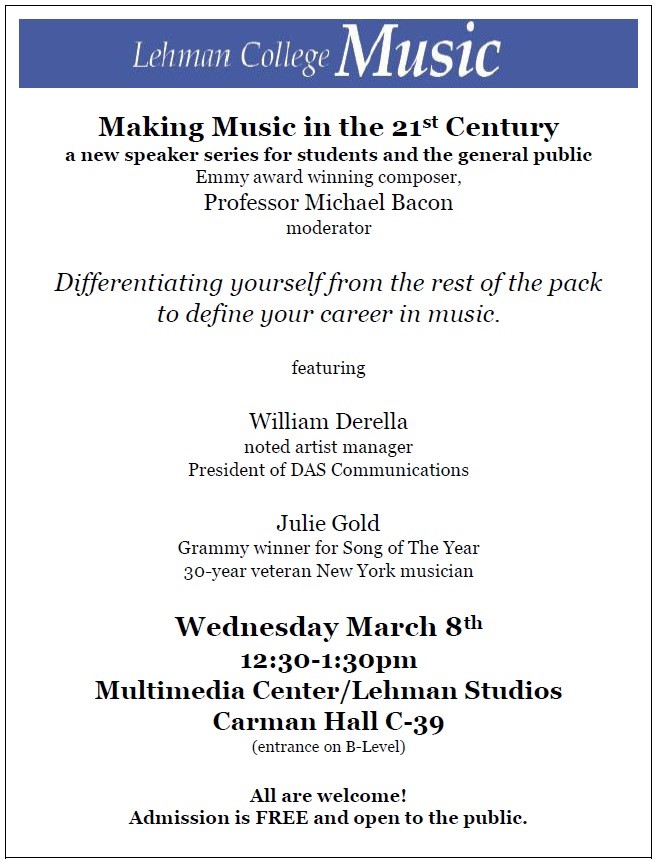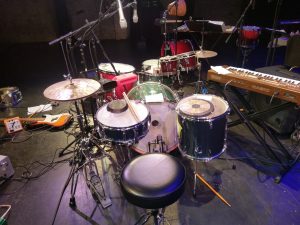While scouring through the links posted on our blog, I found a concert that greatly appealed to me. On the website for (Le) Poisson Rouge (a Greenwich Village space created with the desire to fuse popular and art culture; and where I have enjoyed many an indie rock show), I read about a collaboration with Midtown venue, “The Town Hall,” to present iconic indie band, “Yo La Tengo,” alongside an ensemble of improvising musicians. The concert, entitled “And Then Yo La Tengo Turned Itself Inside Out” (a play on an album name) is part of a new series of shows at The Town Hall called “Improvisations.” Their website describes the series as such: “Improv masters and adventurous performers from multiple disciplines – music, theater, spoken word and more – ply their craft in explorations of this unique artistic language.”
Arriving at the theater early on March 23rd, I had some time to explore. The walls were lined with framed programs going back nearly a century; and featuring performers/composers such as Igor Stravinsky, Richard Strauss, Sergei Rachmaninoff, and Phillip Glass. What an honor for Yo La Tengo to be playing at such a historic venue. That being said, the band has an impressive history of its own. From establishing itself as one of the first indie rock bands over thirty years ago, to revolutionizing the genre with its seamless blending of avant-garde elements, the husband-wife duo’s experimental nature and quirky wit is reflected in how conceived their ironic name. For those interested in the story, it may be found here: https://en.wikipedia.org/wiki/Yo_La_Tengo#Formation_and_early_history.2C_1984.E2.80.9385
Since it would be impractical to discuss every song on the extensive set list, I would like to focus on a few highlights that showcase the diverse nature of the show. Yo La Tengo’s set began with ten-minute long jam, “Let’s Be Still.” While the instrumentation and harmony varied between the studio and live version, the effect was the same. Flute, saxophone, and trumpet were gradually layered on top of a rhythm section grounded by a piano chord progression and two drummers. The focus was not the subdued vocals, but rather the timbre and atmosphere. I found the slow development into a cacophony of sound evocative of the modernist movement in art music. A look at the studio version: https://www.youtube.com/watch?v=GOnKWcL_vzA
An especially elegant blend of art and pop was showcased on two well-known Yo La Tengo tracks; the dreamlike love songs “On Our Way to Fall” and “Black Flowers.” In both, the performance sounded drastically different from the album versions. “On Our Way to Fall” saw xylophone, harmonica, and saxophone creating the accompaniment to lead singer Ira Kaplan’s soft vocals. The most exciting element of the song, however, was the ensemble’s trumpet player and clarinetist soloing during every break in the vocals. And during the performance of “Black Flowers,” saxophone, trumpet, French horn, and trombone replaced the violins that provided the backbone for the album version.
The ensemble’s prominent role was evident on instrumental song, “Green Arrow.” Like much of Yo La Tengo’s work, Green Arrow is a piece that prioritizes atmosphere/mood; which I interpret as drifting between melancholy and nostalgia. While the ensemble respected the repetitive format of the original track, each instrumentalist added in his own flavor. This flexibility led to a much fuller sound than the more minimalist studio version. I couldn’t help but think of the pieces we do in class while observing the improvising performers watch and communicate with each other. [Unfortunately, I was unable to add a video due to size restrictions, but an audio clip is attached below.]
In conclusion, Yo La Tengo’s performance at The Town Hall was not only a thoroughly enjoyable experience, but it perfect achieved (Le) Poisson Rouge’s mission statement: to collide art and popular culture and create something entirely new.







